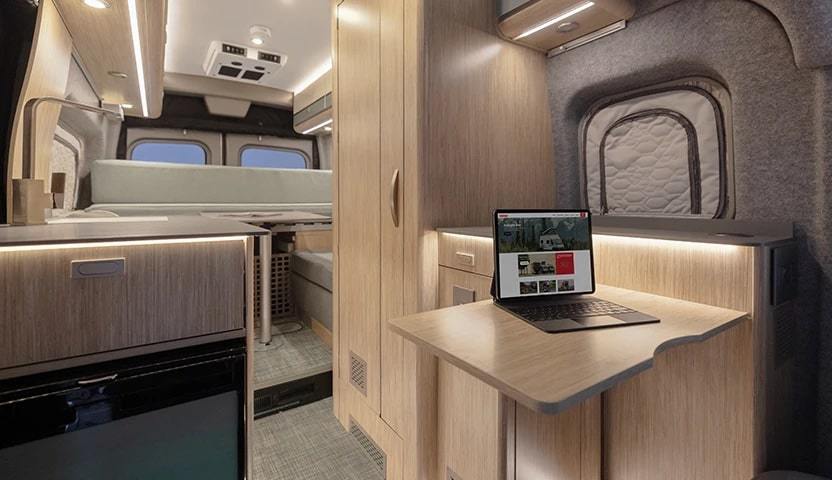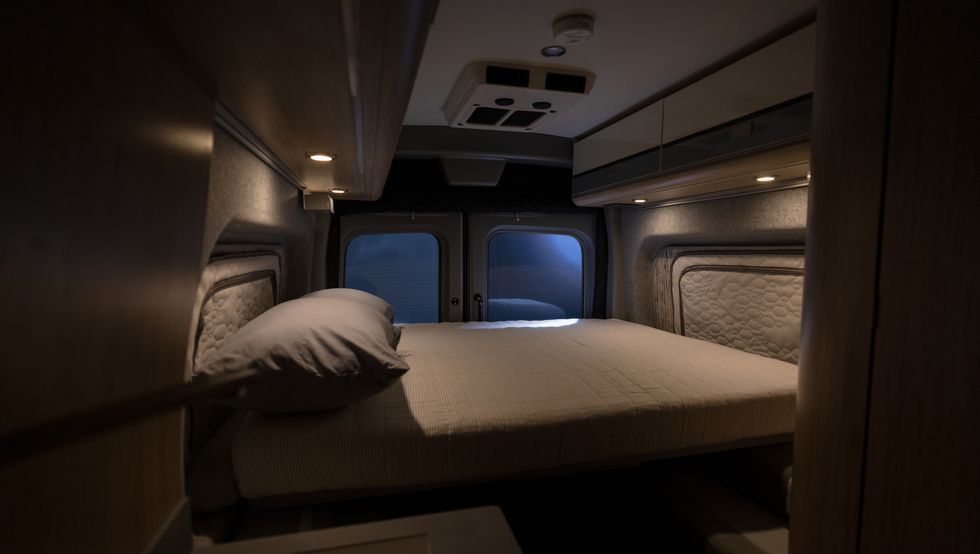Is an EV RV the next big thing? Winnebago thinks so
- PostedPublished 12 December 2023
The Winnebago eRV2 electric motorhome prototype brings fully electrified camping a step closer to reality with a focus on sustainability in the design of onboard amenities, although long-distance touring remains a challenge due to the extra weight and drag from making a Ford E-Transit liveable.

An evolution of Winnebago’s previous e-RV electric motorhome concept, this model has a 198kW/430Nm fed by a 68kWh battery pack that provides a 161-225km of range per charge, much reduced from the 476km unladen range offered by the E-Transit.
Despite this, Winnebago remains dedicated to pushing the boundaries of electrified RVing. Winnebago brand president Huw Bower said the company is “united by a passion to help people explore the outdoors and live a life without limitation”.
To overcome the weight challenge further exacerbated by the 454kg battery, Winnebago teamed up with Genesis Products and Vohringer to come up with a clever interior solution that incorporates recycled VunderTech panels, weighing 45 per cent less than plywood.
Also employed are aluminium supports with lightweight bamboo cabinetry and a 50 per cent recycled moulded polyethylene terephthalate (PET) material utilised as a lighter alternative to traditional wallboard.
Further enhancing efficiency, the eRV2 incorporates roof solar panels, generating up to 900W of power.

This renewable energy is harnessed to charge the eRV2’s innovative lay-flat 48V, 15kWh lithium house battery made by Lithionics, a company Winnebago recently acquired.
Stored beneath the floor, the battery can run all interior amenities for up to seven days, provided that four hours of solar charging per day are achieved and neither heater nor air-conditioning are used.
The eRV2 also introduces the Winnebago Connect System and smartphone app, which enables real-time control and monitoring of various AC and DC-powered devices, such as the 48V air-conditioner that is claimed to be 30 per cent more efficient than traditional units.
Broad-spectrum lighting both enhances visual clarity and enables users to customise its colour.
Fresh and grey water capacities have also been increased to 113 litres and 83 litres respectively over the e-RV, while also featuring convenient monitoring capabilities.
Winnebago’s two-berth prototype blends the principles of Japanese and Scandinavian design aesthetics, fusion the company dubs Japandi.

Its galley is thoughtfully equipped with features, including a marine-grade refrigerator, a portable induction cooktop, and a high-quality residential sink.
The bathroom includes a shower and a removable cassette toilet.
Moreover, the interior of the eRV2 is enhanced with an ingenious L-track storage system that offers flexible organisation options. Towards the rear, a versatile five-in-one sleep and lounge area provides comfortable rest and relaxation.
Two adaptable workspaces are also incorporated, complete with built-in charge ports.
“Our primary goal in building the eRV2 was to help people comfortably explore the world around them with less environmental impact,” said Mr Bower. “The user experience was at the heart of this prototype’s development, through the early days of market research and even now as it goes through field testing. The eRV2 embodies our pioneering legacy, representing not only an achievement in design, innovation, and sustainability but also our commitment to continuously evolve with the changing needs of consumers and the world we share.”
Winnebago is still considering other options for its upcoming e-RV production model including the possibility of changing the chassis from Ford to Mercedes-Benz or Stellantis depending on what works for customers.
A pricing estimate has yet to be announced but expect the e-RV to be well into premium territory.
- CategoriesIn SightGlass
- Tagselectric vehicles, EV, motorhome, RV, SightGlass News Issue 31

